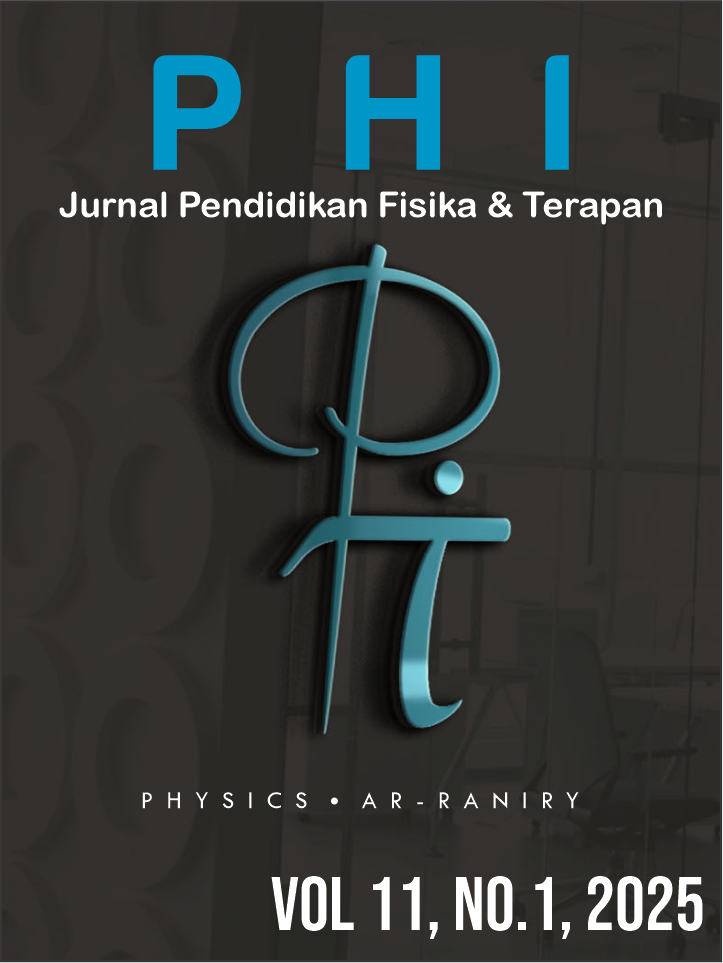Development of E-Module Based Physics Test Instrument: Multiple Choice Test
DOI:
https://doi.org/10.22373/p-jpft.v11i1.28516Keywords:
Multiple Choice, E-Module, Instrumen Test,Abstract
The purpose of this study was to develop a question instrument and describe the validity of reliability, and item analysis. The research design used in developing the instrument is RnD with the 4D method. Based on the results of the analysis and discussion, it can be concluded that the results of expert validation meet the valid criteria. The empirical validity obtained states that it meets the validity criteria with a good category. The results of the reliability test on the product show that the test instrument is quite reliable. The results of the item analysis stated that the instrument was in the category of good difficulty level. In the analysis of item discrimination, there are 15 categories of questions that are feasible to maintain. In the analysis of item distractors, there are 15 questions with distractors that are accepted because they are good enough and there are 5 questions whose distractors are revised. This research is useful for knowing how the level of quality and effectiveness of the development of test instruments.
References
Abdul Qadir, Nuril Huda, D. H. (2024). Analisis Butir Tes : Tingkat Kesukaran, Daya Pembeda Dan Efektivitas Pengecoh. Al Furqan: Jurnal Agama, Sosial Dan Budaya, 3(3), 1450–1467.
Ambarwati, Y. F., & Ismiyati, I. (2021). Analisis Butir Soal Pilihan Ganda Ulangan Akhir Semester Genap Mata Pelajaran Kearsipan. 1(2), 64–75.
Amelia, M. A. (2014). Analisis Soal Tes Hasil Belajar High Order Thinking Skills ( Hots ) Matematika Materi Pecahan Untuk Kelas 5 Sekolah Dasar.
Ardhani, Y. (2020). Kualitas Butir Soal Penilaian Akhir Tahun Mata Pelajaran Teknologi Dasar Otomotif Kelas X Teknik Kendaraan Ringan Otomotif Di Smk Muhammadiyah Gamping Periode 2018/2019. 3(November), 85–94.
Bismy Hafizha Mayara, Emma Yuniarrahmah, dan M. D. M. (2016). Hubungan kepercayaan diri dengan konformitas pada remaja. Jurnal Ecopsy, 3(2).
Dian Ratih Utama Sari, Sri Wahyuni, R. W. B. (2018). Pengembangan Instrumen Tes Multiple Choice High Order Thinking Pada Pembelajaran Fisika. 100–107.
Eliza Pradita, Priarti Megawanti, Y. (2023). Analisis Tingkat Kesukaran, Daya Pembeda, dan Fungsi Distraktor PTS Matematika SMPN Jakarta. HIMPUNAN: Jurnal Ilmiah Mahasiswa Pendidikan Matematika, 3(80), 109–118.
Fatwa Tentamaa, Purwatib, Subardjoc, A. S. N. (2023). Validitas dan reliabilitas konstruk skala intensi berwirausaha untuk siswa sekolah menengah kejuruan: Analisis faktor konfirmatori. Jurnal Psikologi Terapan Dan Pendidikan, 5(1), 23–34.
Kang, H., Scharmann, L. C., Kang, H., Scharmann, L. C., Kang, S., & Noh, T. (2010). DigitalCommons University of Nebraska - Lincoln Cognitive conflict and situational interest as factors influencing conceptual change Cognitive conflict and situational interest as factors influencing conceptual change.
Keumala, M., Khaldun, I., & Hanum, L. (2019). Analisis Butir Soal Ujian Semester Genap Pelajaran Kimia Kelas X SMK SMTI Banda Aceh Tahun Ajaran 2018 / 2019 Menggunakan Program Proanaltes. 4(2), 27–32.
Marthunis, M., Khaldun, I., Mia, X., Mia, X., Mia, X., Mia, X., & Mia, X. (2015). Analisis Kualitas Butir Soal Ujian Semester Genap Mata Pelajaran Kimia Kelas X MAN Model Banda Aceh Tahun Pelajaran 2014 / 2015 Menggunakan Program Proanaltes Pendahuluan Latar Belakang Rumusan Masalah Tujuan Penulisan Manfaat Penulisan Membantu Penentuan Kebijakan Sekolah Selanjutnya . Evaluasi Pendidikan. 1(4), 70–78.
Mita Rahmani, Kurnia Ningsih, A. N. (2015). Jurnal Penelitian dan Evaluasi Pendidikan. 19–36.
Muh Syahrul Sarea, S. H. (2022). Analisis Kualitas Soal Ujian Akhir Semester Mata Pelajaran Kimia. April.
Nadia, S. dan L. (2019). Pengembangan Modul Fisika Pada Materi Tekanan di MTsN. Jurnal Phi, 5(April), 74–80.
Pratama, R. (2023). Pengembangan Tes Diagnostik Four-Tier Multiple Choice Pendeteksi Pemahaman Konsep Materi Sistem Koordinasi. Journal of Education, 05(03), 7012–7019.
Pratiwi, H. Y. (2016). Pengembangan Instrumen Tes Pilihan Ganda. 842–850.
Prihono, E. W. (2019). Validitas Instrumen Kompetensi Profesional pada Penilaian Prestasi Kerja Guru Professional Competency Instrument Validity on The Assessment of Teacher Work Performance. EKSPOSE: Jurnal Penelitian Hukum Dan Pendidikan, 18(2), 897–910.
Reni Wahyuningsih, Sri Wahyuni, A. D. L. (2013). Pengembangan Instrumen Self Assessment Berbasis Web. 338–343.
Sulistiyono, Mundilarto, H. K. (2019). Pengembangan Instrumen Penilaian Kerja Laboratorium Fisika untuk Mengukur Sikap dan Tanggung Jawab Siswa. 9, 43–49.
Wibawa, E. A. (2019). Karakteristik Butir Soal Tes Ujian Akhir Semester. XVII(1).
Yani, M. (2018). Efektivitas Distractor Pada Tes Pilihan Ganda Untuk Mendeteksi Kesalahan Siswa Dalam Menyelesaikan Soal Matematika. 2(2), 125–138.
Hobri, H. (2010). Metodologi Penelitian Pengembangan (Aplikasi Pada Penelitian Pendidikan Matematika). Jember: Pena Salsabila.
Sidabutar, G. D. U., Putrayasa, I. B., & Martha, I. N. (2017). Kualitas Butir Soal Ulangan Akhir Semester Ganjil Bahasa Indonesia Kelas IX SMP Negeri 2 Singaraja Tahun Pelajaran 2016/2017 Ditinjau Dari Segi Taraf Kesukaran, Daya Beda, dan Fungsi Pengecoh. Jurnal Pendidikan Bahasa Dan Sastra Indonesia Undiksha, 7(2).
Downloads
Published
Issue
Section
License
Authors who publish with Jurnal Phi agree to the following terms:
- Authors retain copyright and grant the journal right of first publication with the work simultaneously licensed under a Creative Commons Attribution License (CC BY 4.0) that allows others to share the work with an acknowledgment of the work's authorship and initial publication in this journal.
- Authors are able to enter into separate, additional contractual arrangements for the non-exclusive distribution of the journal's published version of the work (e.g., post it to an institutional repository or publish it in a book), with an acknowledgment of its initial publication in this journal.
- Authors are permitted and encouraged to post their work online (e.g., in institutional repositories or on their website) prior to and during the submission process, as it can lead to productive exchanges, as well as earlier and greater citation of published work (See The Effect of Open Access).

















